Family : Cistaceae

Texte © Prof. Paolo Grossoni

English translation by Mario Beltramini
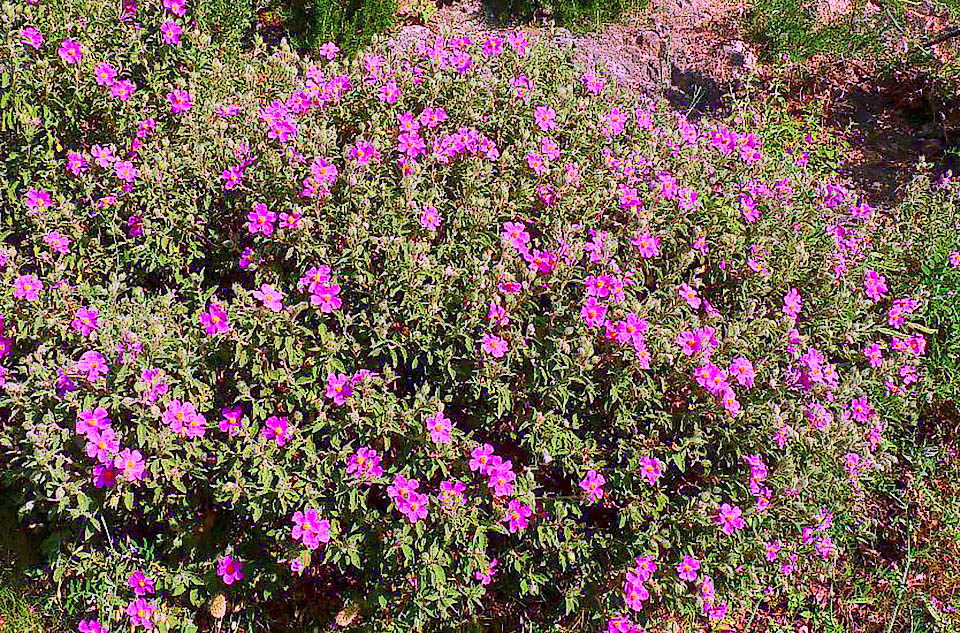
Very common on the island of Crete, Cistus creticus is an evergreen shrub, up to 150 cm tall, with very branched and procumbent crown © lougarou
Cistus creticus L. (1753) belongs to the genus Cistus L. (1753), family Cistaceae Juss. (1789). The nominal epithet ‘creticus’ refers to Crete where it is very common in the rural areas; even if in an incorrect way, are still utilized the two synonyms Cistus incanus auct. and Cistus villosus L.
In Italian it is called Cisto rosso, Rosola, Cisto di Creta, in French Ciste rose, Ciste de Crète, Ciste blanchâtre, Ciste de Corse, in English Pink rock-rose, Cretan rock-rose, Hoary rock-rose (the latter is also used for other rock-roses), in Spanish Jara macho, Estepa menorquina, in German, Kretische Zistrose, Graubehaarten Zistrose.
Cistus creticus is an evergreen shrub, 100-130(150) cm tall, with quite branched and overhanging crown. Due to the dense pubescence covering them, the branches of the year present fluffy and whitish. Under prolonged drought the plant tends to develop dwarf branches (brachioblasts ) with pseudo-verticillate leaves, more coriaceous and much smaller in size.
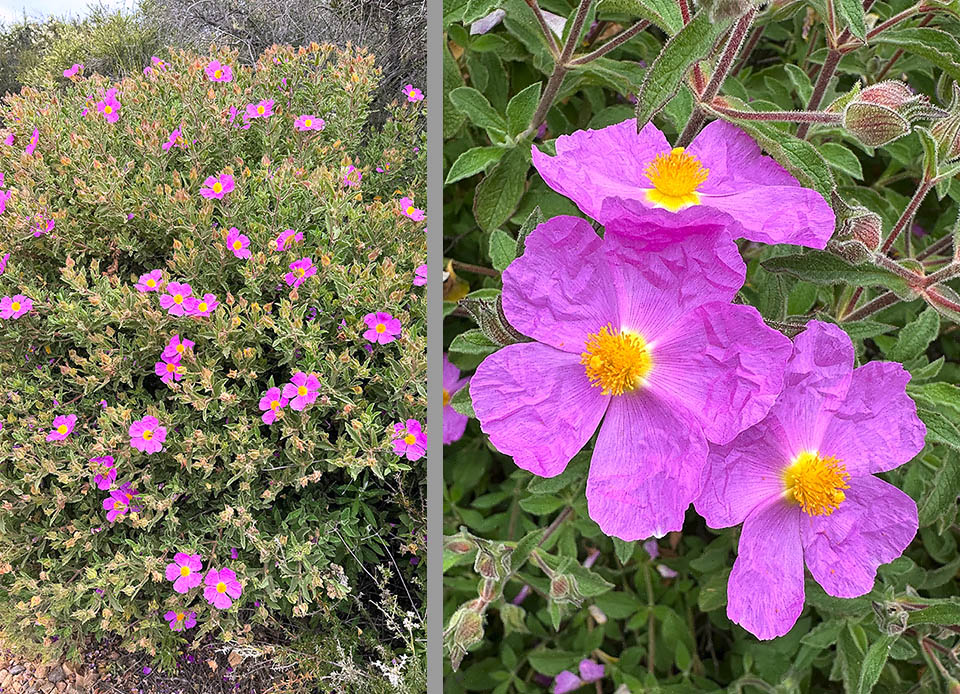
Due to the thick pubescence, the year branches appear fluffy and whitish. The spring flowers, hermaphroditic, are 1 to 8 carried by umbelliform terminal inflorescences © timbuktu (left) © Mark K. James (right)
The leaves are opposite, decussate and subamplexicaul with short (3-15 mm) petiole or, in the upper leaves, almost null whilst the lamina is rather small, 20-50 x (8)10-20 mm, coriaceous, sub-round to oblong-lanceolate; above it is wrinkled-reticulated, green and grey-green, under is clearer and with a marked nerval reticulum. The margin, marked by a dense whitish tomentum, is whole and often wrinkled.
The flowers, hermaphroditic and in number varying from 1 to 8 on terminal umbelliform inflorescences, are carried by 5-15(30) mm long pedicels, robust and thickly pubescent that begin at the axil of lanceolate bracteiform leaflets. The blooming is vernal and may continue up to the end of June.
The corolla, ephemeral, has a diameter of 4-5 cm; has 5 petals varying from light pink to purple pink with, usually, a light yellow basal claw; the appearance is creased and the margin is denticulate. The calyx is formed by 5 long hairy triangular sepals, the three outer ones being bigger. The stamens, numerous and of orange yellow colour, surround the thin pistil.
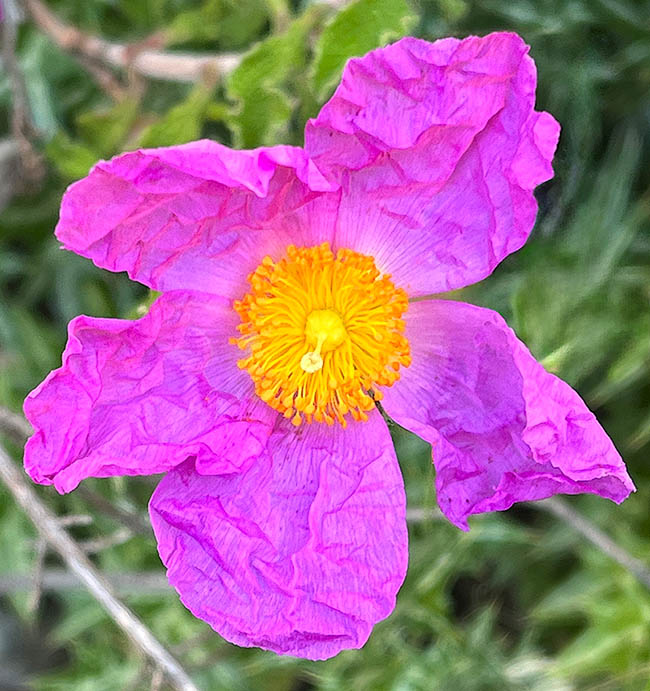
The 4-5 cm broad corolla, ephemeral, with 5 crumpled petals as in other cistus, may have various red shades © Bob Walker
The pollination is entomogamous. The fruit is a 7-9 mm dehiscent capsule, ovoid, brown, villous and internally distributed in 5 chambers; ripens between late summer and early autumn but remains on the plant until the cold season when it frees numerous 1-1,2 mm seeds of straw yellow colour. The chromosome number is 2n = 18.
Thermophilic and heliophilic species, it wants sunny soils, well drained, possibly sandy or stony, it is indifferent to Ph, provided not as long it is not extreme. For a short time it tolerates temperatures up to -10/-12 °C, otherwise the plant is to be protected during the winter period.
Like the other rock-roses, in the event of a fire, is an active pyrophyte for the resilience of the undamaged gems of the basal tuft as well as, in the seeds, for the physiological adaptations (dormancy) and and morphological (hardness of the seed coats and conformation of the embryo) that allows them to overcome the catastrophic event unscathed.
The Pink rock-roses grow along the margins of shrub formations in the subshrubs and in the garrigues often associated with Cistus salviifolius L. When competition and/or grazing are reduced the renewal can be as strong as to form even extensive cisti.
Cistus creticus is present in large part of the Mediterranean regions: it’s spontaneous in Morocco, in central-eastern Iberian Peninsula (basin of the Júcar river and Minorca) and in southern France (Provence and Corsica) but, limited to the Mediterranean coasts, is much more common from Italy and relevant islands up to the Balkan peninsula, to eastern Aegean islands, to Crete, to Cyprus and along the coasts of Asia Minor. It has naturalized in Australia, in New Zealand and in California.
The Pink rock-rose is mainly an ornamental plant that enters the clade PPC (‘Purple Pink Clade’) but is utilized for stabilizing loose soils or preventing erosions after the passage of the fire.
The honey is very much appreciated and the resin, quite similar to the ‘labdanum’ of the ladaniferus rock-rose, is employed in the production of cosmetics and perfumes, in the confectionery industry as a flavouring and, due to its anti oxidant and anti-inflammatory properties, in herbalism. The ‘De materia medica’ written by Dioscorides Pedanius (first century AD) indicates it as diuretic, analgesic and cough suppressant. The infusion of the dried leaves is used to obtain a herbal tea rich in polyphenols and antioxidant flavonoids.
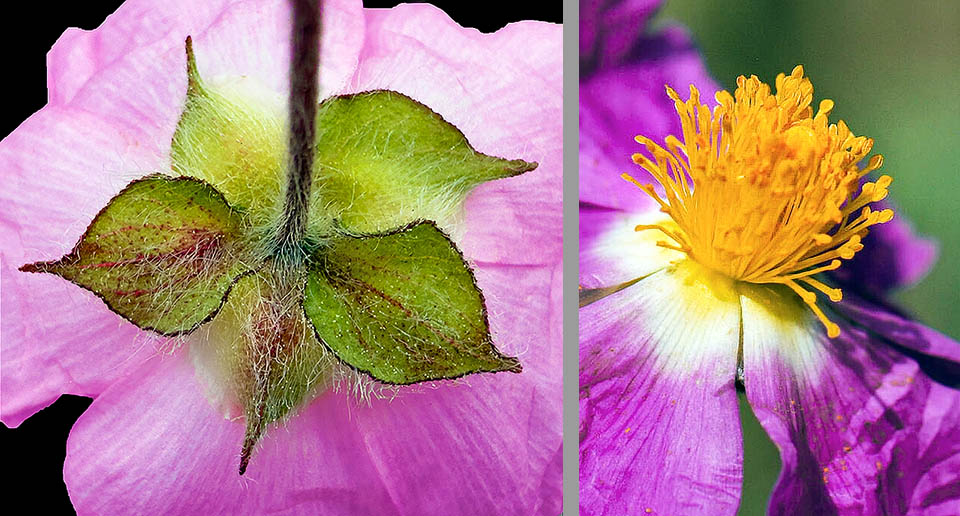
Calyx is formed by 5 hairy triangular sepals, with the 3 outer ones bigger. The basal nail of the petals is pale yellow. Several orange yellow stamens surround the thin pistil © Giuseppe Mazza (left) © Konrad and Roland Greinwald (right)
Yore, the high degree of polymorphism among the plants of pink rock-rose has caused frequent variations in its nomenclature. Linnaeus himself, in the several editions of his “Species Plantarum”, changed for three times the nominal epithet of the taxon: in 1753 incanus, in 1762 creticus and in 1764 villosus. The first epithet came into common use and only in 1981 the question was clarified by Greuter and Burdet who recommended also to replace it with the binomial Cistus creticus L. being this the priority binomial.
The species is subdivided in two subspecies (WFO World Flora Online, 2025) :
subsp. creticus; present in the Eurasian sector of its range;
subsp. trabutii (Maire) Dobignard (1992); endemism of Morocco, is smaller in size with smaller leaves and with very elongated inflorescence peduncles.
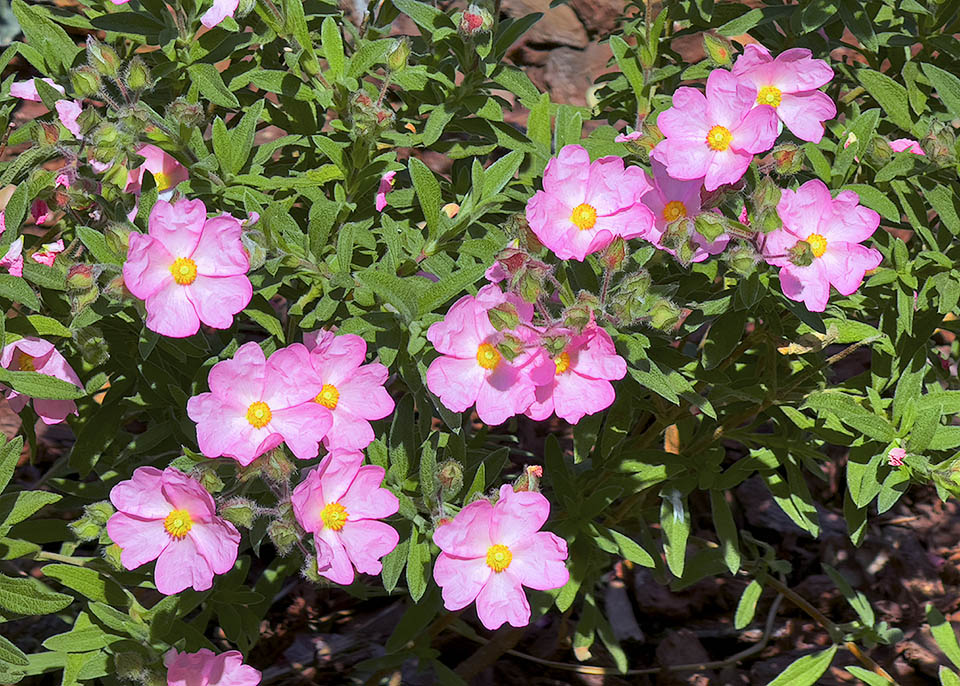
A clear, pinkish, flowers variety with sharp leaves. The margin is however marked by a dense whitish felt © Giuseppe Mazza
Various floras and catalogues report still two other subspecies, subsp. corsicus Loisel. and subsp. eriocephalus (Viv.) Greuter & Burdet, that, however, have been rejected as illegitimate names being the first synonym of Cistus creticus whilst the second is synonym of Cistus tauricus C.Presl.
Recently (2021) a study, carried in the University of Vienna by Brigitte Lukas and collaborators on plants of pink rock roses sampled throughout the range, has evidenced also through genetic analyses that the species can significantly be divided into two clades: the populations of the eastern part of the Mediterranean characterize for several peculiarities of primitiveness whilst those of the western part have more recent characters introduced in the genome due to hybridizations also with rock roses of other PPC species occurred during migratory waves that have occurred over time.
However, being not involved in the formation of typifying morpho characters, these genetic variants have not allowed further taxonomic divisions within the subspecies.
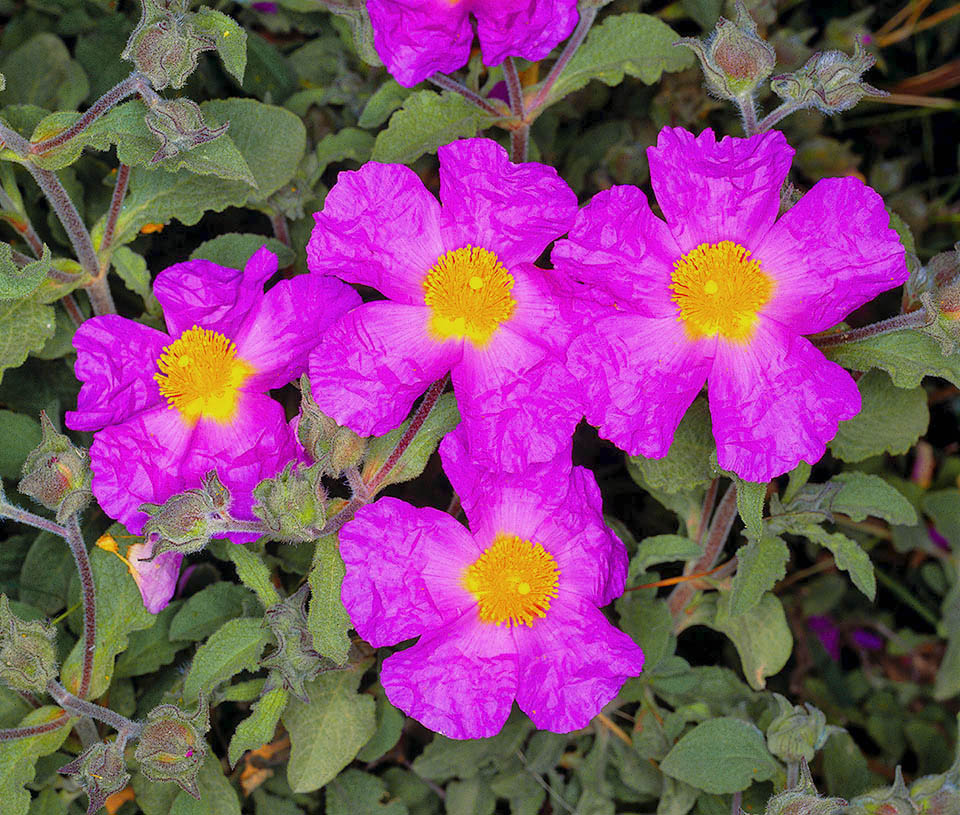
Instead here the leaves are less pointed and the petals colour, very intense, tends to be purplish red © Giuseppe Mazza
Several synonyms of the species are known but few varieties mostly with white flowers, f. albus (O.E.Warb.) Demoly (that includes also the cv. ‘Tania Compton’) and cv. ‘Lasithi’; the cv. ‘Bali’ has bright pink flowers. The synonyms accepted or still employed for Cistus creticus are numerous.’WFO (2025)’ lists only one synonym for the subsp. trabutii (Cistus villosus var. trabutii Maire) and 44 for the subsp. creticus.
Besides the obsolete Linnaean binomials Cistus incanus L. and Cistus villosus L. we can find Cistus creticus subsp. corsicus (Loisel.) Greuter & Burdet, Cistus creticus subsp. eriocephalus (Viv.) Greuter & Burdet, Cistus garganicus Ten. Cistus incanus L. [non ×incanus], Cistus incanus subsp. creticus (L.) Heywood, Cistus incanus var. creticus (L.) Boiss., Cistus ladanifera Garsault, Cistus ladaniferus Stokes, Cistus polymorphus Willk. (binomial declared ‘illegitimate name’), Cistus salviifoliu Pall., Cistus villosus Auct. an L., Cistus villosus L., Cistus villosus subsp. creticus (L.) Nyman), Cistus villosus var. creticus (L.) Boiss. and Cistus undulatus Sweet. Is utilized also Cistus ×incanus L. (= Cistus ×pulverulentus Pourr.) that, however, as the spelling indicates, does not identify a species but a hybrid, natural, between Cistus albidus and Cistus crispus.
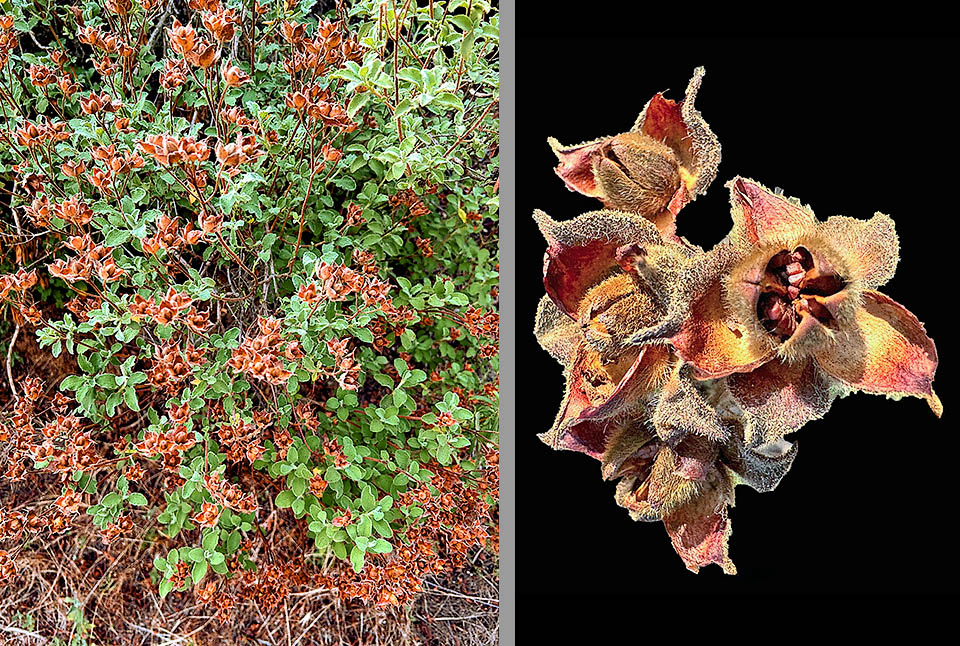
Blooming is abundant as can be noted from the fruits that keep on the plant until winter, when they free the seeds. The 7-9 mm dehiscent capsules have 5 chambers © manyenglishes (left) © hasenzahn (right)
Several are the natural or artificial hybrids of the pink rock rose used in the ornamental green. Usually they are crosses with species of the clade PPC (‘Purple Pink Clade’), such as Cistus ×canescens Sweet (with Cistus albidus L.), Cistus ×crumleyae Demoly (with Cistus ochreatus C.Sm. ex Buch), Cistus ×escartianus Demoly (with Cistus heterophyllus Desf.), Cistus ×lucasii Demoly (with Cistus chinamadensis Bañares & P. Romero), Cistus ×ralletii Demoly (with C. symphytifolius Lam.) but there are also hybrids with species of the clade WWPC (‘White or Whitish Pink Clade’): Cistus ×conradiae Demoly, (with Cistus monspeliensis L.), Cistus ×purpureus Lam., with dark nail, and relevant variety (with Cistus ladanifer L.) and Cistus ×sammonsii Demoly (with Cistus laurifolius L.).
Finally, there are hybrids due to multiple hybridizations. Keeping in mind that Cistus ×canescens is hybrid between Cistus creticus and Cistus albidus L.), are triple hybrids: Cistus ×argenteus Dans. (with Cistus laurifolius L. × Cistus ×canescens) and relevant varieties, Cistus ×tephreus Demoly, (with Cistus heterophyllus Desf. × Cistus ×canescens), Cistus ×gardianus Demoly (with Cistus crispus L.×Cistus ×canescens) and Cistus ×latipes Demoly (hybrid with Cistus parviflorus Lam. ×Cistus sintenisii Litard).
→ To appreciate the biodiversity within CISTACEAE family please click here.
